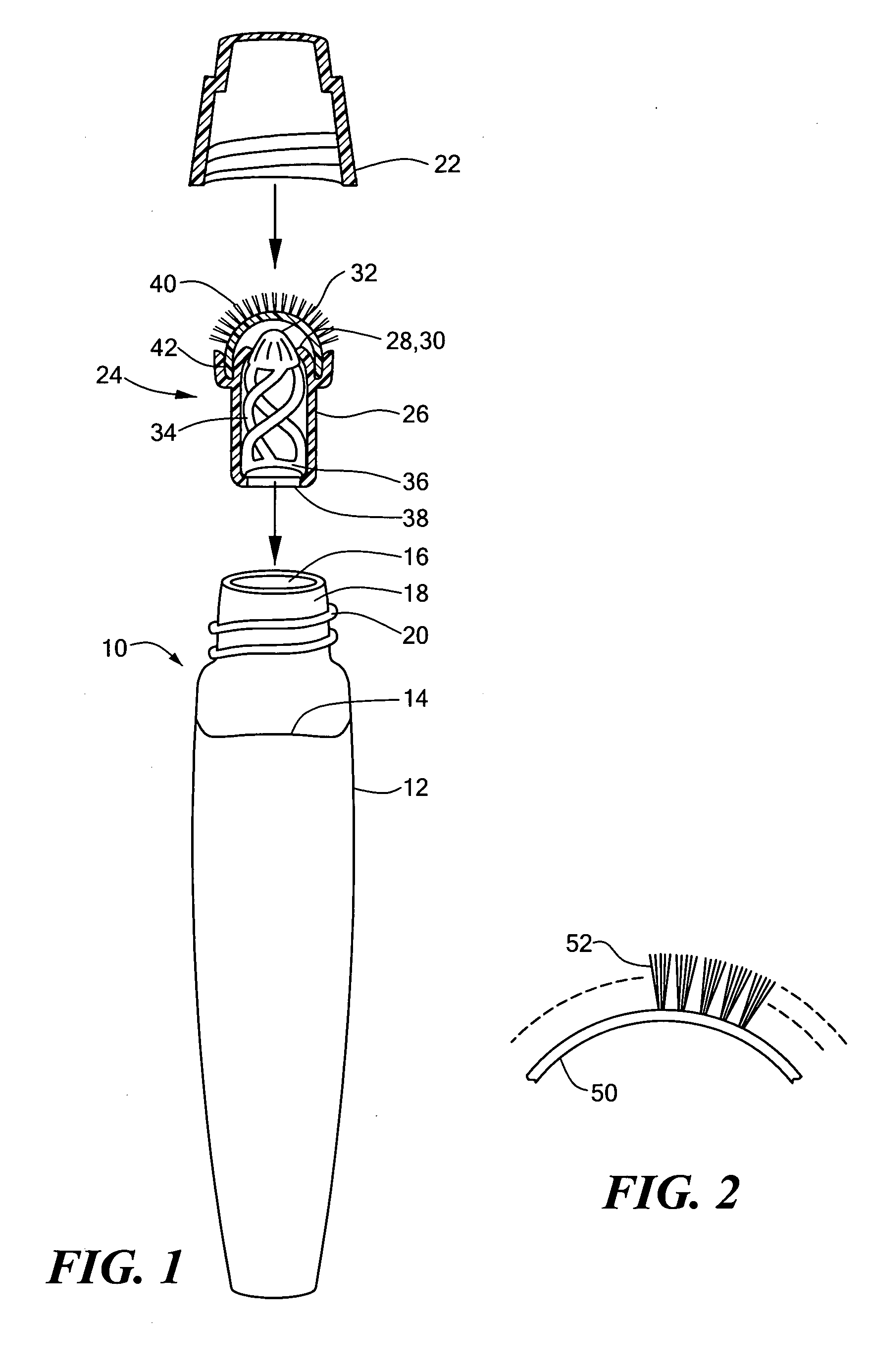[0012] This invention concerns nail polish removal from fingernails and toenails (collectively termed nails), and, more specifically, to providing a hand-held liquid solvent-dispensing and application device. The device includes a vessel similar in size to a marker or pen, that includes both a liquid shut-off valve
assembly (e.g., a mechanical push-valve) and a solvent applicator element (e.g., a compliant layer of solvent-permeable material) that is positioned outside the valve. The applicator element allows distribution of a nail polish remover solvent over the surface of the nail and scrubbing of the nail surface to loosen and remove the nail polish. The material used in the applicator element is preferably a tufted or textured fabric which is of a material such as Dacron which is chemically resistant to the remover solvent and permeable to the solvent. The applicator element can also be an
open cell mesh or foam material, or other porous material, provided that it is also resistant to the remover solvent and compliant to the nail surface. The invention also includes a method for applying the remover solvent to the nail surface. This method differs from that previously used in which a pen fitted with a porous marker-style nib is provided for removing or repairing small areas of
lacquer on a nail. Furthermore, with the presently described dispensing device, there is almost no
delay between the time the compliant applicator is pressed downward against the nail surface, and the time the liquid shut-off valve (i.e., push valve) releases solvent through the applicator material onto the nail. The compliant applicator element can be easily configured and amply sized to cover an entire fingernail with one or two back and forth passes over the nail.
[0013] The present invention is intended to provide improved economy of solvent use, and improved convenience when compared with the traditional and rather messy cotton ball that is saturated with solvent for application to the nail. It is also intended to overcome the previously described limitations inherent in nib-containing nail polish correction pens. The present invention utilizes a suitably sized applicator element that includes a layer of compliant material that is both solvent-resistant and solvent-permeable and that can transmit but not retain appreciable quantities of liquid solvent. The applicator portion is also enlarged relative to the size of a writing nib and forms one end of the marker. It is located distal or outside the valve
assembly that controls the flow of solvent. Rather than being pointed or protruding like a
chisel tip or bullet tip, the surface of the applicator is typically flat or somewhat rounded (preferably convex outward) to facilitate contact and smooth movement over the surface of the nail. The applicator is adequately sized (preferably between 0.5 cm and 2 cm in
diameter or width) so that it can cover between 25% and 100% of the nail at a time. In that manner, an individual nail can be covered with solvent in a few seconds. In order to allow time to remove solvent-softened
nail lacquer using a tissue,
cotton material or
paper towel, for example, it is desirable that the solvent not evaporate too rapidly. Such solvents having reduced volatility compared to
acetone or methyl and
ethyl acetate are described by Perlman (U.S. Pat. No. 6,521,572).
[0015] The applicator in accordance with the invention is softer, larger and more compliant than known nib devices so that it may contact a much greater portion of the nail surface at a given time. In addition, because the applicator surface is generally aligned perpendicular to the axis of the device rather than parallel (as in the case of the nib), the applicator can be more easily manipulated and controlled than a conventional nib, thereby adding utility to the device. Besides allowing convenient and rapid
coating of the nail with
lacquer removal solvent, the applicator can be fabricated from a textured material that helps to scrub, disrupt and remove
nail lacquer from the nail as the lacquer becomes softened by the solvent. Thus, the applicator plays a
dual role of both applying solvent and then dislodging lacquer as it is softened. Moreover, since the applicator material does not retain appreciable volumes of lacquer residue, the applicator is easily cleanable by wiping off the residue with an absorbent tissue or other material. Definitions
[0021] The expression “can be operated with its major longitudinal axis essentially perpendicular to the surface of a nail” means that the device can be conveniently held at approximately a right angle to the main surface portion of the fingernail or toenail while releasing solvent onto the nail and
rubbing the applicator surface over this surface to remove
nail lacquer.
[0033] In a preferred embodiment, the applicator material is, furthermore, compliant to the nail surface during use so as to increase the extent of contact between the applicator's surface and the surface of the nail. This increased contact facilitates coverage of the nail with the lacquer removing solvent.
 Login to View More
Login to View More  Login to View More
Login to View More 

